When I heard news a couple of years ago that there was going to be a film version of Brideshead Revisited, I was cautiously excited. After all, there has been an acclaimed miniseries version in 1981, starring Jeremy Irons and Anthony Andrews, but never a big-screen adaptation. It's taken a while for the film to materialize, but it's finally here and set to debut in September. The other day I heard there would be tickets to see the premiere here in Edmonton in a week, and I was excited to see it. That is, I was, until I saw the trailer.
The first time I encountered Brideshead Revisited was several years ago on a quiet Sunday afternoon in Vancouver in the home of one of my English Professors, Dr. Klassen. I had heard him speak about the book and miniseries before, and when my friends and I mentioned we'd neither read nor seen the story, he ushered us into the family room to watch an episode.
From the moment I first saw the first chapter--"Et in Arcadia Ego"--it was love at first sight. At the end of term I rushed out and rented the miniseries, and in the months that followed, I read the novel, along with a number of Evelyn Waugh's other books.
What did I find so appealing about the story? Brideshead Revisited is a book that speaks a great deal about faith and loving difficult people (little wonder that my favourite book of all time is A River Runs Through It). The characters in the novel are layered individuals, which is why the new film version is likely--scratch that--CERTAIN to cause disappointment.
Brideshead Revisited was based on the reminiscences of Charles Ryder (played in the miniseries by Jeremy Irons), who befriended the aristocratic Sebastian Flyte (Anthony Andrews in a standout performance) while studying at Oxford. The two men formed an extremely powerful bond and Ryder soon became a regular guest at Brideshead, the Flytes' ancestral home. Ryder is attracted to Sebastian's fabulous wealth and privileged existence, but he is baffled by the deep ties Sebastian and his family have to the Catholic faith. Over the years, he watches as his friend Sebastian falls into the grips of alcoholism and becomes romantically involved with Sebastian's sister, Julia. But the relationship between Charles and the once-divorced Julia is severely challenged by the fact that they cannot marry in the Church.
Rumour has it that the new film version will focus on the relationship between Charles Ryder and Julia Flyte, rather than the friendship between Charles and Sebastian, which goes completely against the novel (Charles and Julia's love affair is more of a secondary aspect of the book's plot). Moreover, the trailer suggests that Sebastian's mother objects to the marriage of Charles and Julia on the grounds that Charles is not an aristocrat. In the novel Charles' social position and wealth has nothing to do with his difficulties with Julia: the Flytes' faith--not their money--is the main hurdle Charles cannot overcome.
The new film version has chosen to downplay the issue of faith in favour of a sort of teen-romance, class-warfare plot line. While this can work very well in stories like the recent film Atonement (which I loved), it somehow falls rather flat in this case. For one thing, Charles Ryder was quite wealthy in his own right (as was Evelyn Waugh, as the story is somewhat autobiographical). The only difference is that his family's money is from their own enterprise, rather than inherited. And part of the point of the book is that the Flytes (well, apart from Julia herself) are NOT snobs. Sebastian freely welcomes Charles into his circle without a second thought, and any objections Lady Flyte might have to Charles are religious, not financial.
Wednesday, July 30, 2008
Brideshead Revisited--Revisited
Posted by
Margaret
at
5:05 AM
7
comments
![]()
![]()
Tuesday, July 29, 2008
The Nazarenes--The Other Artistic Brotherhood
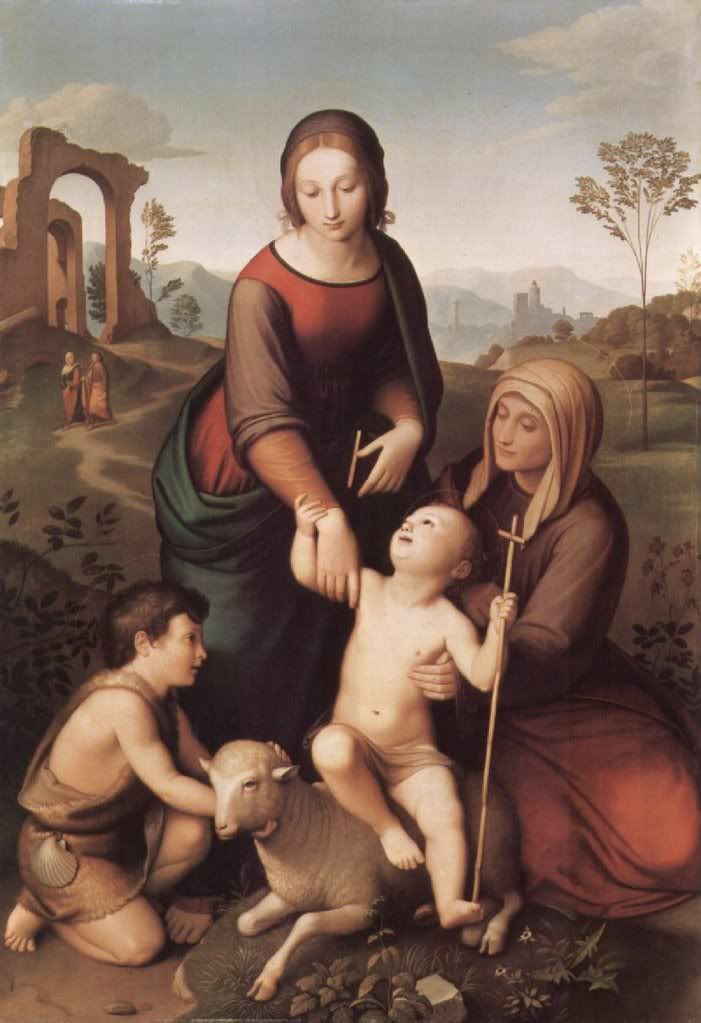
Thanks to a thought-provoking conversation over at Victoria magazine's forums, I once again ran across the subject of the Nazarenes in connection with the Pre-Raphaelite Brotherhood. I've read over and over again that Dante Gabriel was fascinated by the Nazarenes, but in the past I'd just overlooked it. This time I decided to delve a bit deeper into the relationship between the Pre-Raphaelites and this group of 19th century ascetic German painters.
Did you know that the Nazarenes were one of the key influences on the Pre-Raphaelite Brotherhood? And no, by Nazarenes I'm not referring to the modern day religious denomination! The Nazarenes I'm talking about were a group of 19th century German artists who joined together in 1809 to form the Brotherhood of St. Luke of Vienna. The founding members of the Brotherhood were Franz Pforr and Johann Friedrich Overbeck. They got the nickname "Nazarene" because of their long hair and ascetic convictions.
Although the Brotherhood began in Vienna, Franz and Johann traveled to Rome in 1810 to live and work at the abandoned convent of Sant'Isidoro del Pincio. After arriving in Rome, the artists began fervently proselytizing art was a divine mission, elevated to the level of true faith. The Brotherhood was especially influenced by Fra Angelico, Van Eyck, Albrecht Durer and--brace yourselves--the early works of Raphael (Raphael was clearly not as popular with the Nazarene's followers, the Pre-Raphaelites").
The key tenet of the Nazarenes' philosophy was that creating art, whether it be poetry or painting--was a divine calling. This was boldly demonstrated in Nazarene arist Phillip Veit's frescos in the Villa Massimo in Rome (1819), where he chose to include three of Italy's greatest poets, Dante, Ariosto, and Tasso, next to the saints and Church fathers.
The Brotherhood of St. Luke of Vienna worked hard to purify themselves of worldly cares, and dedicated their lives to a near-monastic existence. Their devotion to simplicity and sincerity of expression was later transcribed into the Pre-Raphaelites' own doctrine:
1. To have genuine ideas to express;
2. To study Nature attentively, so as to know how to express them;
3. To sympathise with what is direct and serious and heartfelt in previous art, to the exclusion of what is conventional and self-parodying and learned by rote;
4. And, most indispensable of all, to produce thoroughly good pictures and statues.
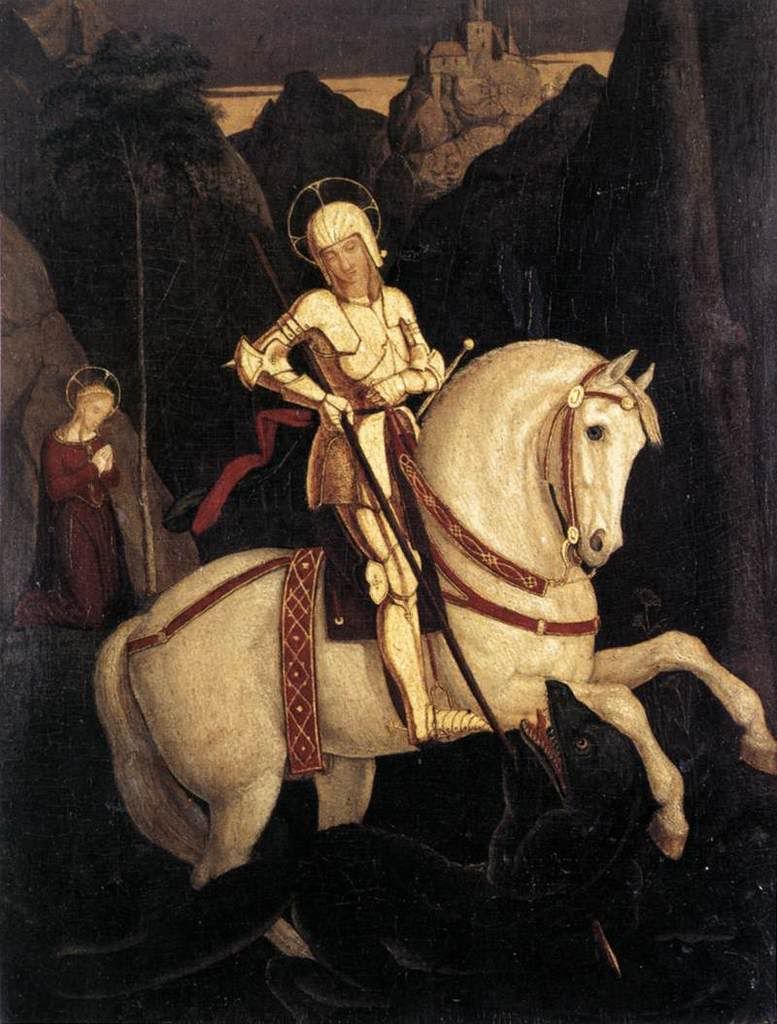 You can tell from this 1811 painting of St. George and the Dragon by Franz Pforr that, like the Pre-Raphaelites, the Nazarenes shared an interest in subjects from medieval myths and legends, although the Nazarenes were perhaps more slavishly devoted to medieval style. Even Dante Gabriel Rossetti, whose work is most imitative of the Nazarenes, was much more liberal in his use of colour.
You can tell from this 1811 painting of St. George and the Dragon by Franz Pforr that, like the Pre-Raphaelites, the Nazarenes shared an interest in subjects from medieval myths and legends, although the Nazarenes were perhaps more slavishly devoted to medieval style. Even Dante Gabriel Rossetti, whose work is most imitative of the Nazarenes, was much more liberal in his use of colour.Painting, top left: Friedrich Overbeck's Maria and Elizabeth, 1825
Works consulted: Arthistoryarchive--a great art history website with a lot of information on the Nazarenes.
Posted by
Margaret
at
5:47 AM
2
comments
![]()
![]()
Labels: pre-raphaelites
Monday, July 28, 2008
More from Quinta de San Pedro Alejandrino

The Quinta de San Pedro Alejandrino and Bolivarian Museum is a tranquil oasis in the midst of bustling Santa Marta, Colombia, and a place I would recommend to any visitor. The other day I discussed the older portion of the Quinta, but I would like to take some time to examine the newer part as well.
Above you can see the building that houses the "Country's Altar" located at the end of the Flags Square at the Quinta de San Pedro Alejandrino. Constructed in 1930, it is the most recent addition to the property and definitely in better shape than the original villa.
Housed within the surrounding marble structures (which were constructed even more recently) is the Bolivarian Museum of Contemporary Art, which has a fine collection of art from all around Latin America. Most of the art has a "Bolivarian" theme and is related to themes of the Spanish conquest, or liberation from colonial rule.
In case you are wondering, the ants you can see on the outside of the building were part of an art installation--not a permanent aspect of the structure! (I accidentally stumbled into a storage room filled with paper-mache ants--kind of creepy! I really don't like bugs--even giant paper bugs!).
Here we can see the top portion of the "Country's Altar," which depicts the ideals on which Colombia was built. Simón Bolívar is shown at the top. The other figures represent justice (left) and work (right).
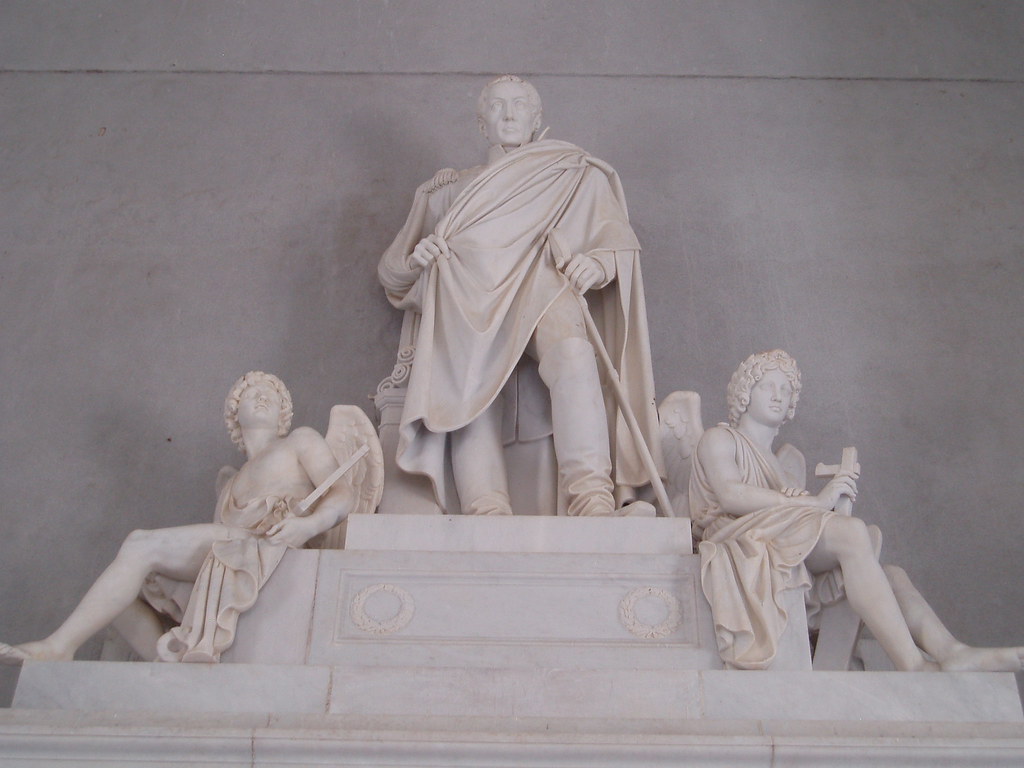
Another view of the courtyard.

The mural below was painted in 1998 and is located on a wall just outside the courtyard. It depicts various scenes from the life of Simon Bolivar. The mural is probably almost 100 feet wide and recounts numerous episodes from Bolivar's action-packed life. Here we can see the Liberator (seated on horseback) fighting bravely against the Spanish.
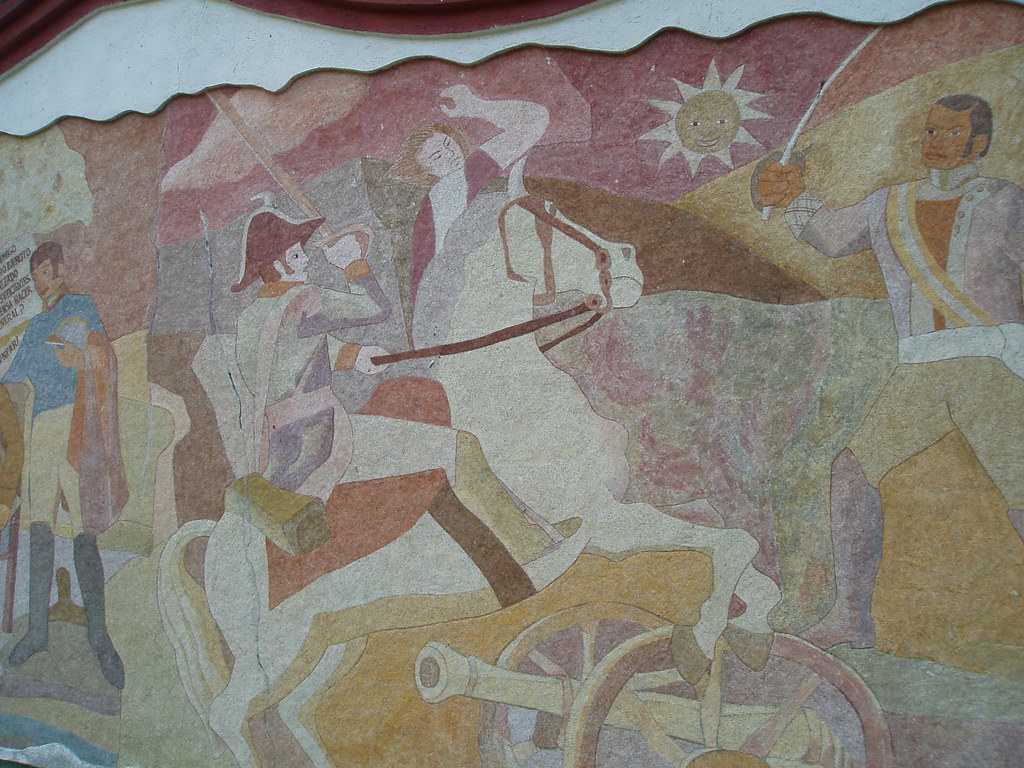
All of the countries that were liberated (or partially liberated) by Bolivar donated plaques to commemorate the construction of this monument. Here's a picture of Peru's donation (and of me with Aunt Carmen!).

I really loved seeing all the beautiful colonial architecture at the Quinta, but this newer part was beautiful as well. You could really tell that Santa Marta has invested a lot in making the Quinta de San Pedro a great tourist attraction. Our guide told us that the city of Santa Marta regularly holds benefits and other charity events in the museum and on the grounds. There is definitely a sense of "living history" here!
Posted by
Margaret
at
5:57 AM
2
comments
![]()
![]()
Saturday, July 26, 2008
Bits of Paradise from across the Blogosphere
One of my favourite things about blogging is that it introduced me to a whole world of beautiful people and things I might have otherwise missed. It's so easy to go through life without taking time to enjoy all the beauty there is in this world, but blogging forces me to slow down a little and take time to appreciate the little bits of paradise all around us. I saw so many beautiful posts this week that I decided to make a little link post featuring some of my favourites. 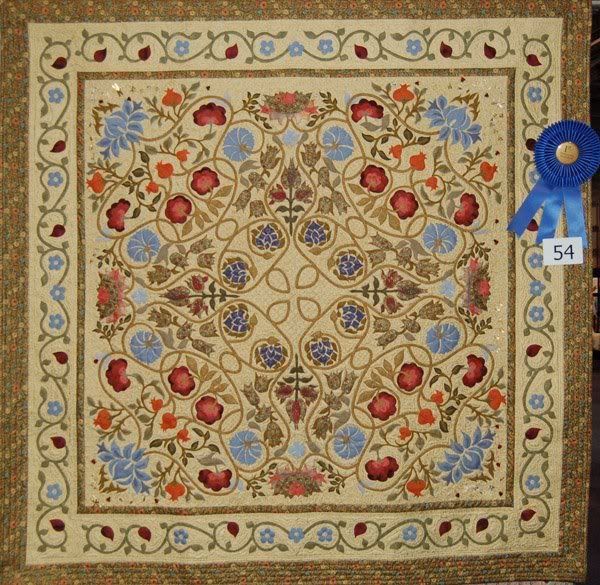
I'm always fascinated by the beautiful works of art so many of you create. I did a post a while ago on Michelle Hill's beautiful William Morris-inspired quilts, and I just discovered the other day that she has her own blog, William Morris in quilting. Be sure to visit her blog to catch a glimpse of her latest projects! (Right now Michelle is busy producing a book on Morris that will be coming out in 2009).Tracy, who never ceases to inspire me with her constant creativity, just spent what appears to have been a heavenly vacation in England. She posted some photos of her trip to Kent that simply took my breath away. I haven't been to England since highschool, but seeing photos like these makes me ache to go back. Visit this lovely picture-filled post--"England--Until We Meet Again"--and be transported!
 Gillian of Reflections in the Afternoon did another beautiful photoblog post on her trip to Banff and Lake Louise. The photographs made me feel like I was right there! I live very close to Banff, but I always seem to go in the winter. It's a real treat to see photos of the park during the summertime when everything is so full of life.
Gillian of Reflections in the Afternoon did another beautiful photoblog post on her trip to Banff and Lake Louise. The photographs made me feel like I was right there! I live very close to Banff, but I always seem to go in the winter. It's a real treat to see photos of the park during the summertime when everything is so full of life.  Valerie at Acorn Moon is a spectacular artist in her own right. But she did a great interview on her blog last week with illustrator Patricia Papps that I really enjoyed. Papps' art is inspired by William Morris, Art Nouveau, and Egypt...can you tell? Papps illustrates a lot of children's books--I'd love to get my hands on one, her artwork is so beautiful and imaginative--two things I think are key to illustrating books for children.
Valerie at Acorn Moon is a spectacular artist in her own right. But she did a great interview on her blog last week with illustrator Patricia Papps that I really enjoyed. Papps' art is inspired by William Morris, Art Nouveau, and Egypt...can you tell? Papps illustrates a lot of children's books--I'd love to get my hands on one, her artwork is so beautiful and imaginative--two things I think are key to illustrating books for children.
Posted by
Margaret
at
6:33 AM
2
comments
![]()
![]()
Labels: blogging
Friday, July 25, 2008
Life with iphone

My dear husband picked me up an iphone 3G yesterday, and I have to say I was thrilled. Believe it or not, the iphone is my first cellular phone EVER. It's not that I'm against cellphones, I've just never really wanted/needed one enough to get one. Now that I'm doing more blogging, though, I thought the iphone would be a perfect tool for working on the go.
For those of you who weren't aware of it already, the first generation of the iphone was not available in Canada due to some problems with Canada's leading wireless carrier, Rogers. In fact, Apple even threatened to pull the iphone 3G from Canadian stores at the beginning of this month because Rogers refused to offer an unlimited data plan to Canadian customers (for those of you who are not intimately acquainted with the capacity of Canadian wireless carriers to rip-off customers, they are a virtual/literal mafia that have been price gouging defenseless Canadian customers for years--another of the main reasons it's taken me this long to get a phone).
What I love about the iphone so far:
1. The touch screen keypad. This is actually a common complaint among reviewers of the iphone, but because I'm not used to regular cell phones key pads, I find the touch sceen easier to use.
2. The sleek design. I guess it's a given, but the phone is gorgeous and the display is easy to read and understand, even for someone like me who knows nothing about phones.
3. The precise mapping technology. Okay, so it's INCREDIBLY disturbing my phone can pinpoint the side of the BUILDING I live in using google maps (I'm looking at it as I type). But it's also really useful! You can get directions anywhere so easily it's not even funny. It's sort of pointless for me, since I don't drive and we have OnStar, but oh well. It's awfully cool. Maybe I can use it when I'm walking!
4. It's cheaper and does more! Now there's less reason than ever to buy an ipod touch.
5. The Stocks application rocks. Okay, so I don't even have a penny inveseted in the stock market at this time, but this application is easy to use and beautiful. I'm hooked.
Of course, me being me, although I'm in love with my iphone, I have a long list of improvements I would like to make (even after only a few hours of use). My biggest beefs with the iphone?
1. My number one frustration with the iphone would have to be the lack of copy/paste features.
I was really hoping to do a lot of blogging with my iphone, but without the ability to copy/paste, it simply takes too long to do any serious blogging (just try copying an url without copy/paste!), or even emailing. Apparently I am not alone in being frustrated with this aspect of the iphone, as this great post on macworld testifies. I don't really know what on earth apple was thinking when they left this feature out. Copy/paste is pretty much essential for folks who are heavy net users(the number one reason I bought the iphone in the first place).
What is apple doing about this? Not much. This has apparently been a major complaint since the first iphone was released. And while a third-party developer has created an application to copy text within the iphone's "note" application, this still doesn't solve the problem for those of us who want to be able to copy text on the web or within emails (the iphone won't let you transfer text within applications).
2. No external keyboard/mouse option. There are times when you want to be able to type on a keyboard and copy/paste with a mouse. If I could use a bluetooth external keyboard and mouse with my iphone, it could actually replace my laptop for pretty much everything. I understand they want to minimize clutter, but I really don't get why apple is not doing this.
3. Landscape/widescreen feature only works in some applications. You've probably seen that the iphone has a "widescreen" feature that self-adjusts to allow you to view webpages and video in widescreen by simply turning the screen. Cool, right? Well, it's nice, but it only works with certain applications. For example, while you can view the internet in widescreen, most of the menus are only visible in the vertical (narrow) view.
4. There's no video recording or zoom on the camera. I didn't expect it, but it would have been really nice to have, and a number of other new phones from Nokia, Samsung, LG and Motorola do this.
5. The battery doesn't last long in 3G mode. About 3 1/2 hours, to be precise, if you're just surfing. Working at a normal pace, with some phone calls thrown in and taking a few breaks, it could probably realistically last you all day. I've seen some users suggest turning off the 3G when you aren't using it to save battery power.
Bottom line? The iphone is beautiful and functional, but it won't be replacing your laptop any time soon.
iphone photo courtesy of apple.com
Posted by
Margaret
at
4:44 AM
7
comments
![]()
![]()
Labels: technology
Thursday, July 24, 2008
Quinta de San Pedro Alejandrino in Santa Marta
One of the highlights of our trip to Colombia was seeing the Quinta de San Pedro Alejandrino in Santa Marta (a quinta is sort of a big farm in Spanish). The villa is the site where Simón Bolívar--known in Colombia as the Liberator--lived out his last days. For those of you who are not familiar with Bolívar, he holds a place in Colombian history somewhat akin to George Washington in the United States. The home is actually known as the "Sanctuary of the Motherland," and it has been well-preserved--by Colombian standards. The site is a gem that contains numerous artifacts from Bolívar's time and is definitely a must-see. 
A shot of the family at the Villa. From left to right: My Father-in-Law, Fabio, Aunt Carmen, Me and Javier
The original building dates back to the 17th century. Since it was the last place Simón Bolívar lived, it has historical significance for the modern nations he liberated from Spain--Colombia, Venezuela, Ecuador and Panama. The main house is a Bolivarian museum that is worth seeing, though the preservation of many of the items is depressing (as a historian I wanted to cry when I saw such valuable original artifacts left to rot in the tropical heat and humidity).
A shot of the interior courtyard
The estate also houses a sugar mill, which has been more or less dismantled, although the outside of the structure is still lovely. One wonders why the government hasn't provided any funding for a proper restoration of the property, but then, this is Colombia we are talking about after all. 
San Pedro Alejandrino Villa is open to the public from 9:00 a.m. to 5:00 p.m. Be sure to get a guide! Our guide, Manuel, was amazing--he knew all about the history of the villa and gave us lots of time to take pictures, which is always a plus. Overall I was really impressed, despite my disappointment with the museum's lack of attention to historical preservation. Oh well, you can't have everything!
Posted by
Margaret
at
5:32 AM
2
comments
![]()
![]()
Wednesday, July 23, 2008
Julia
While I was at home a week ago with my mom in Olympia, she shared one of her favourite films with me: Julia. She's told me about the movie with me my entire life, so I was really excited to finally get a chance to see it!
Julia, starring Jane Fonda and Vanessa Redgrave, is a story about the lifelong friendship between author Lillian Hellman and "Julia." It is a tale of two best friends who grow apart over the years but whose friendship with each other always remains a key factor in both their lives. When Julia, played by Vanessa Redgrave, goes to Vienna to study medicine before the outbreak of World War II, she becomes involved with a group of students who are attempting to overthrow the Nazis. Jane Fonda stars as Lillian Hellman (you may remember Hellman as the author of The Children's Hour and The Little Foxes), alongside Jason Robards as Dashiell Hammett (author of The Maltese Falcon).
It was only after watching Julia that I did a bit of research and discovered that this film (which I would venture to say is not very well known today) was actually a critical and box office success at the time of its release. The film was nominated for 11 academy awards and won 3, including best supporting actor (Jason Robards), best supporting actress (Vanessa Redgrave) and best adapted screenplay (Alvin Sargent). Fred Zinnemann, who piloted projects such as A Man For All Seasons (1966) and High Noon (1952) directed.
I've always wondered why this film wasn't released on DVD sooner, and I suppose there are a couple of key reasons. The first is that when this film was came out, it was made controversial by the fact that Vanessa Redgrave and Jane Fonda--both well-known at the time for their activist roles--had the starring roles in the film. But controversy tends to make films even MORE popular, so the more likely reason for the disappearance of this film is the fact that most people now believe that Lillian Hellman actually made the entire story up. Although she claimed that "Julia" was a pseudonym for an actual person who had been her best friend, she had absolutely no data to support her claims. After all, relatively few wealthy Americans who had graduated from Oxford had really been studying in Vienna during WWII, she would have been fairly easy to find.
But where did Hellman get the character of Julia? In 1983, Yale University Press published the memoirs of psychoanalyst Muriel Gardiner, who had been a member of the anti-Fascist resistance during her days as a student in Vienna. The book, called ''Code Name 'Mary,''' cast serious doubts on Hellman's reliability as an author and led many to believe that she had lied about her source for the character of Julia. Gardiner herself felt the resemblance was remarkable, but she had never actually met Hellman. You can read more about the publishing controversy here, in a 1983 article from the New York Times.
Whether or not the story is true, it remains a beautiful tale about friendship. I loved the movie, although I was disappointed to find out that Lillian Hellman might have made the entire story up. But I still enjoy the film.
I tried to find some good clips on YouTube, but unfortunately there are only two, and both clips give away a good portion of the plot! But if you HAVE seen the movie before, these clips are great (especially the second one).
***Spoiler warning*** This is a great clip that features some fabulous acting by Vanessa Redgrave. However, don't watch it if you haven't seen the film!
Posted by
Margaret
at
9:05 AM
4
comments
![]()
![]()
Tuesday, July 22, 2008
Christ in the House of His Parents, Sir John Everett Millais
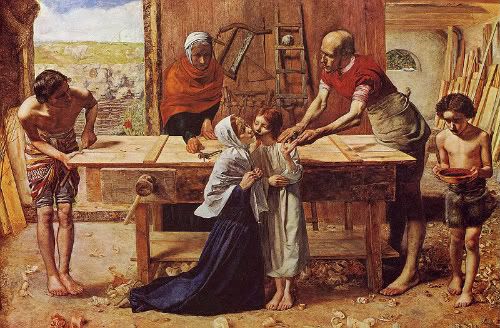
Christ in the House of His Parents was first exhibited by John Everett Millais at the Royal Academy in 1850 when he was was just 20 years old. The work was accompanied by a quote from Zechariah 13:6 "And who shall say unto him, What are these wounds in thine hands? Then he shall answer, Those with which I was wounded in the house of my friends."
The symbolism in this painting is particularly rich. Furthermore, because the story of Christ is well-known by most viewers, it's quite easy to analyse the painting. It is evident a young Jesus has somehow injured his hand after trying to remove a nail from the door on the work table with the pliers (some of his blood is visible on the door). The blood from the wound in his hand has also trickled onto his foot, foreshadowing the crucifixion. We can see his cousin John (the Baptist), on the right bringing him water to wash his wound--prefiguring, of course, Christ's baptism. Behind Christ's head at the top of the ladder in the background you can also see a dove, symbolising the Holy Spirit. Immediately above his head are Joseph's carpenter tools, suggesting the "crown of thorns" and representing the tools of his crucifixion.
Millais has placed an unfinished basket in the left foreground, signifying the work the remains to be done in Jesus' life. In the right background you can see a candle burning in the window, representing time. I also loved the way that Millais set up a cross pattern behind the young Jesus. By placing Christ in the centre of the painting, the worktable forms a cross with his body. Then, above his head you can see a cross formed out of the crack in the wall and the end of the saw. Can you see it?
The painting elicited a strong reaction among critics. Charles Dickens was deeply offended by the stark realism of the work, which he considered ugly and blasphemous (Blackwood's Magazine reacted similarly). Moreover, with its emphasis on child baptism and the necessary separation between the church (Christ and his family) and the laity (persons who are not clergy--depicted in the painting as the penned sheep). Nevertheless, despite whatever theological objections Ruskin had to the work, he continued to defend Millais against the critics, saying "Millais first showed me the beauty of extreme minuteness and precision."
Works consulted: Robert Hewison. Ruskin, Turner and the Pre-Raphaelites. London: Tate Gallery Printing, 2000, 30.
Posted by
Margaret
at
9:45 AM
3
comments
![]()
![]()
Labels: millais, pre-raphaelites
Monday, July 21, 2008
William Holman Hunt, Isabella and the Pot of Basil 1866-1868
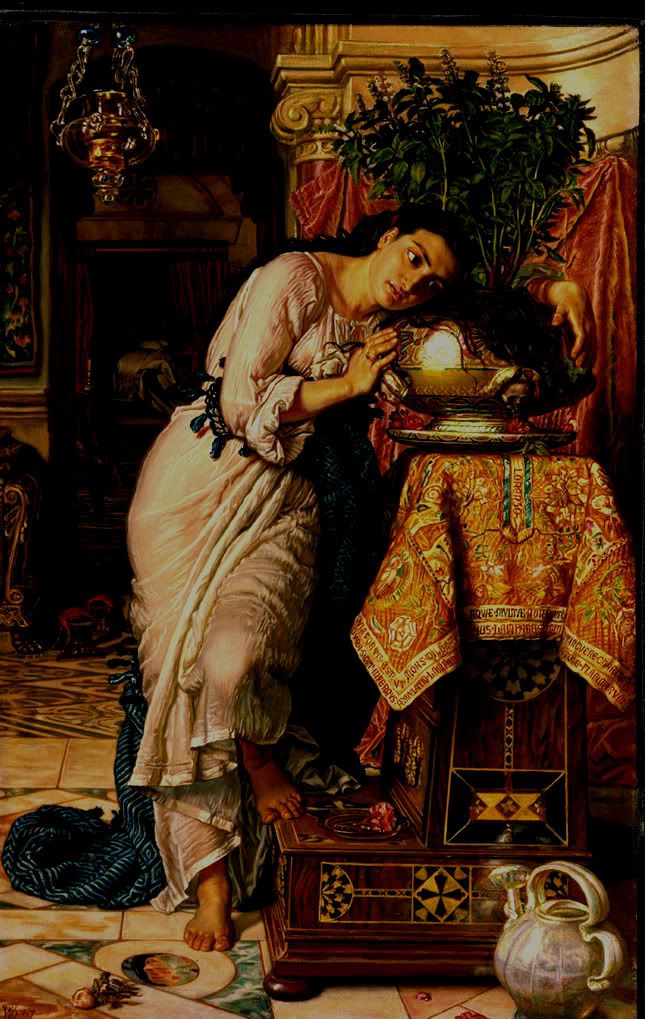
Like Sir John Everett Millais, William Holman Hunt also chose Keat's poem "Isabella, or, the Pot of Basil" as the subject for one of his paintings. Unlike Millais, whose Lorenzo and Isabella was based on the first part of Keats' poem, Hunt chose to illustrate a scene from the second half of the poem, which was inspired by the writings of Boccaccio.
By this point in the poem, Isabella has gone to the grave yard and unearthed the head of Lorenzo from its resting place. She wraps it in a silk scarf and puts it in a garden pot, as described in the 52nd-54th stanzas of the poem:
LII.
Then in a silken scarf,—sweet with the dews
Of precious flowers pluck’d in Araby,
And divine liquids come with odorous ooze
Through the cold serpent pipe refreshfully,—
She wrapp’d it up; and for its tomb did choose
A garden-pot, wherein she laid it by,
And cover’d it with mould, and o’er it set
Sweet Basil, which her tears kept ever wet.
LIII.
And she forgot the stars, the moon, and sun,
And she forgot the blue above the trees,
And she forgot the dells where waters run,
And she forgot the chilly autumn breeze;
She had no knowledge when the day was done,
And the new morn she saw not: but in peace
Hung over her sweet Basil evermore,
And moisten’d it with tears unto the core.
LIV
And so she ever fed it with thin tears,
Whence thick, and green, and beautiful it grew,
So that it smelt more balmy than its peers
Of Basil-tufts in Florence; for it drew
Nurture besides, and life, from human fears,
From the fast mouldering head there shut from view:
So that the jewel, safely casketed,
Came forth, and in perfumed leafits spread.
Hunt used his wife Fanny, who was eight months pregnant at the time, as his model for Isabella. Their son Cyril was born a month later in October of 1866, but Fanny had a difficult time recovering her strength after the birth. She died on the 20th of December. Fanny and Hunt had only been married for 11 short months.
The painting took on a new meaning after Fanny's death. Hunt worked feverishly on the canvas, which was over 6 feet tall (73.5 x 45.5 in or 187 x 116 cm)(Hawksley, 94). I love the way that Isabella's hair mingles with the soil in the pot--it's such a beautiful depiction of her grief and her longing to be joined again with Lorenzo. Hunt would have certainly had a more emotional connection to the subject after his wife's death.
Work Consulted: The Essential Pre-Raphaelites by Lucinda Hawksley, published by Dempsey Parr.
Posted by
Margaret
at
9:21 AM
2
comments
![]()
![]()
Labels: medieval, william holman hunt
Sunday, July 20, 2008
Reminder to Submit Art History Articles
I'm back in Canada! I arrived home on Friday after a long week of replacing my documents. The whole experience was pretty awful, but I guess I'm greatful that the theft happened close enough to my mom's house that I was able to get copies of my birth certificate, etc., so that I could renew my passport. I can't even imagine how hard it would have been if I'd had my passport stolen in a foreign country!
I took it easy this weekend because I was still pretty tired. This afternoon I suddenly realised why I've been feeling a little travel-weary...my husband reminded me that I've been traveling pretty much non-stop since May!
We saw so many amazing things on our trip to Colombia, and in the days and weeks to come, I hope to write several more articles about our travels. I will also be publishing the next edition of The Art History Carnival on August 1st (I was too busy to do an issue this month!). Please submit your blog article for the next edition of the Art History Carnival using our carnival submission form. For more info on submission guidelines, visit this post about the carnival, or check out the first issue of the art history carnival.
I've received a lot of great art history articles already and I look forward to seeing more!
Technorati tags:
art history carnival, blog carnival.
Posted by
Margaret
at
6:58 PM
1 comments
![]()
![]()
Labels: blog carnival, travel
Wednesday, July 16, 2008
Lorenzo and Isabella by Sir John Everett Millais
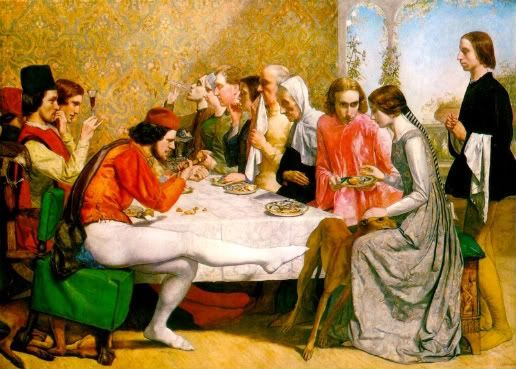
The first painting by Sir John Everett Millais to include the initials "P.R.B." was Lorenzo and Isabella, first exhibited at the Royal Academy in 1849 along with Holman Hunt's Rienzi. If you look closely, you will see the Pre-Raphaelite Brotherhood's distinctive monogram displayed on the leg of Isabella's stool.
The painting is based on Keat's poem "Isabella, or, the Pot of Basil." The poem tells the story of Isabella and Lorenzo falling in love. After their affair, her jealous brothers murder Lorenzo. When Isabella finds his body she removes his head, which she promptly deposits in a pot. She then sets to growing basil in the pot. It's a rather sordid and excessively dramatic tale, originally taken from Boccaccio. It's not that surprising that Keats chose this subject matter though--he was a mere 19 years old when he wrote the poem!
Lorenzo and Isabella is remarkably detailed and demonstrates the tremendous promise Millais showed as an artist (he was only 20 years old!). I am particularly fond of the faces in this painting, many of which were based on well known associates of the Brotherhood. Dante Gabriel Rossetti can be seen drinking on the right hand side of the table. His brother William Rossetti is Lorenzo (seen passing the fruit to Isabella). Millais' sister in law is posing as Isabella. The man whose face is visible on the back lefthand side is Walter Deverell. The man kicking the dog was actually John Harris, a man who had bullied Millais when he was in school!(Hawksley, 20).
Source consulted: Lucinda Hawksley, The Essential Pre-Raphaelites.
Image courtesy The Rossetti Archive.
Posted by
Margaret
at
7:27 AM
5
comments
![]()
![]()
Labels: millais, pre-raphaelites
Monday, July 14, 2008
Secrecy and the Pre-Raphaelite Brotherhood
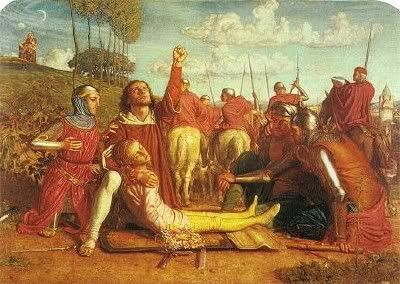
Did you know that the meaning of the Pre-Raphaelite Brotherhood was originally a secret?
When the Pre-Raphaelite Brotherhood first appeared, the members of the Brotherhood signed their paintings with the secret monogram "PRB." According to legend, the significance of PRB was unknown for almost two years, until it was leaked by a journalist who had received a tip from the sculptor Alexander Munro.
They say that "loose lips sink ships," and it was Dante Gabriel Rossetti who was responsible for leaking the Brotherhood's secret. He rather indiscreetly told Alexander Munro in 1850 about the identity of the brotherhood and then swore him to secrecy.
Munro didn't manage to keep the secret very long. The news that PRB stood for "Pre-Raphaelite Brotherhood" rocked the art world and caused a great deal of speculation amongst the public. The Victorian public immediately conjectured that the Pre-Raphaelites were some kind of secret Catholic society hell-bent on taking over the British art world (while James Collinson, Christina Rossetti's fiance, was a devoted Catholic, most of the other members were not).
The image shown above is William Holman Hunt's Rienzi, painted in 1849. The painting was the first of William Holman Hunt's canvases to include the initials "P.R.B.".
Posted by
Margaret
at
12:57 PM
1 comments
![]()
![]()
Labels: pre-raphaelites, rossetti
Sunday, July 13, 2008
Stolen Documents
Well, I will be staying in Washington for longer than I had previously thought!
My passport and identity documents (not to mention credit cards and the like) were stolen on Friday from my Grandmother's car while we were at North Beach in Deception Pass State Park near my Grandparents' home in Anacortes. I even saw the thieves, who saw me put my purse in the trunk of Grandma's car. I felt very uneasy about putting my new purse in the car, but I shrugged it off. I'd just returned from three weeks in Colombia and figured I was being paranoid.
Well, I wasn't!
When we got back from the beach, my Grandma's window had been broken in and the thieves had stolen NOTHING in the car, except my purse from the trunk, so it was clearly the two suspicious looking guys that had seen us putting the purse in the car earlier.
I'm pretty upset about the whole thing. I was supposed to fly home on Tuesday, but I had to reschedule my flight so I would have time to get a new passport. I really hope that I'm able to get a new one with the documents that I have here. It's amazing how many pieces of secondary I.D. that they expect you to have! I called the State Department and they told me I needed pieces of photo identification (preferably) with my name, place of birth and signature. I don't really have any of this, because the thieves STOLE MY I.D.! Arggh.
What's really frustrating is that I'm now totally open to identity theft. I mean, they have my passport and driver's license! Plus, if they have the intelligence to do a google search, they'll find my website immeadiately. Message to the theives: If you want to keep my purse, go ahead! But please send me my documents! And next time you might want to determine whether there was anything valuable in the vehicle before you bash the windows in. It's a tremendous amount of effort to expend for virtually no reward (I didn't have a dime in my purse). The purse itself was the only thing worth anything--it's probably being sold on eBay as we speak.
Oh well, hopefully by Friday I will have all new identification documents. But I have to say this experience has been extremely disheartening. I mean, what kind of person would break in the window of an 79 year old woman's car? It's about as parasitic as it gets. Real criminal masterminds, throwing a rock through granny's windshield.
I was pretty peeved at first. I still am, though I comfort myself by remembering that what goes around comes around. And hopefully, I'll be able to get a passport so that I can return home! I have a lot more sympathy for people without documents right now. It sucks!
Posted by
Margaret
at
4:52 PM
4
comments
![]()
![]()
Thursday, July 10, 2008
Title Page of the Kelmscott Chaucer

The Kelmscott edition of The Works of Geoffrey Chaucer is considered by many specialists in antiquarian books to be one of the finest works of English book production. Without a dout it certainly was the most impressive achievement of Morris' Kelmscott Press.
The Kelmscott Chaucer was a monumental undertaking that severely taxed William Morris and his colleagues. By the time Morris began designing the title page for the volume in February 1896, his health was poor and he was suffering from extreme exhaustion. His friend Sir Edward Burne-Jones was afraid Morris would be unable to complete the project, remarking "I am getting very anxious about Morris and about the Chaucer. he has not done the title-page yet, which will be such a rich page of ornament, with all the large lettering. I wish he would not leave it any longer" (as quoted in Zaczek, 32).
Morris did complete the project in May of that year, but at the expense of his health. Burne-Jones assistant remarked during the process that Morris appeared "very ghostlike, feeble and old looking"(32). The Chaucer was released for publication in June, but the damage to Morris fragile health had already been done. He died only four months later.
The title page, with its richly interwoven grape vines remains one of Morris' crowning achievements as a draughtsman and a testament to his avility to imagine incredibly organic patterns.
Posted by
Margaret
at
2:07 PM
5
comments
![]()
![]()
Labels: books, kelmscott press, william morris
Wednesday, July 9, 2008
Rolling Stone's Daughter Marries in Pre-Raphaelite Inspired Wedding Gown
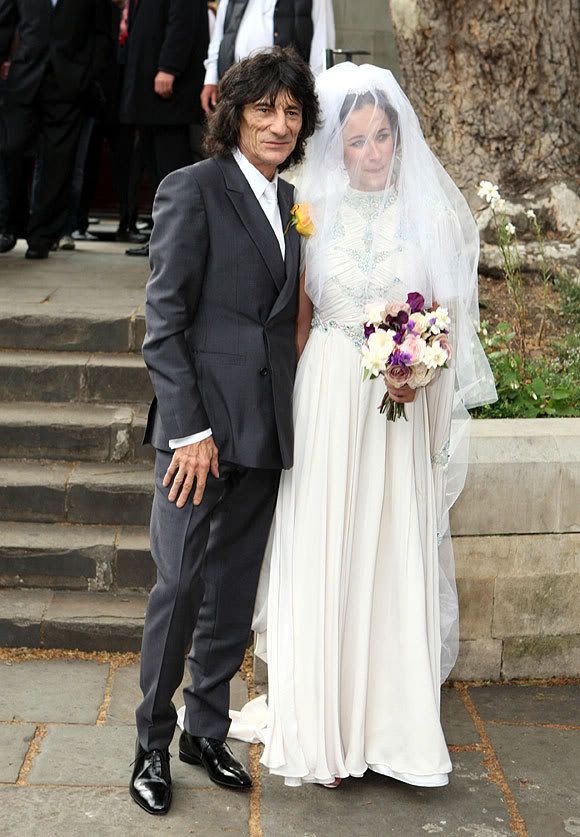
Leah Wood, daughter of Rolling Stones rocker Ronnie Wood, was married to TV Producer Jack McDonald last month at Southwark Cathedral. Her Pre-Raphaelite inspired gown was the toast of the affair. It featured a pleated bodice, intricate embroidery, draping sleeves and a juliet cap (I haven't seen one of those in a while!). Her bouquet also had an old fasioned feel, and was made of pale pink roses, irises and other more traditional flowers.
Afterwards the wedding party headed to the reception (which was held at Ronnie Wood's mansion in Surrey), which was based around the theme Shakespeare's A Midsummer Night's Dream. What a lovely idea!
Posted by
Margaret
at
11:17 AM
3
comments
![]()
![]()
Labels: fashion
Tuesday, July 8, 2008
William Morris' La Belle Iseult

La Belle Iseult is the only painting by William Morris that exists today. The subject of the painting is Tristram's lover Iseult, and it was painted around the same time that his first book of poetry, The Defence of Guenevere , was published. It is probably for this reason that the subject of this painting is often believed to be Guinevere (both date from 1858).
William Morris composed several sketches prior to executing La Belle Iseult. In addition, the painting is believed to be partly inspired by a mural he painted in the Oxford Union in 1957.
The model for the painting is Jane Burden, who married Morris the following year. The work reveals that Morris was not as accomplished in working with oils as his friend Rossetti, as Jane appears rather pale and stiff in this rendering. Morris, who was well aware of his shortcomings as a painter, wrote with charming humility on the canvas, "I cannot paint you, but I love you."
Like many of the Pre-Raphaelite paintings, La Belle Iseult depicts a romanticised vision of the Middle Ages. And while the figures appear a bit uninspired, the textures of textiles the painting are quite striking. This work was finished long before the advent of William Morris' decorating company, but the details evident in the painting, such as the wall, bed and floor coverings--not to mention the lovely pattern on Iseult's dress--all bear witness to Morris' unparalleled talents as a draughtsman and foreshadow his involement in textile design. You will also notice that the book on the nightstand has also been carefully designed.
I adore this work. While Rossetti was much better at capturing the sensuous qualities of Jane and his other models, I think Morris' painting does an incredible job of envisioning a creative, romantic space. It gives one quite the "scope for the imagination"--don't you think?
Source Consulted: The Essential William Morris by Ian Zaczek, p. 16
Photo courtesy of the Tate Gallery
Posted by
Margaret
at
10:30 AM
5
comments
![]()
![]()
Labels: jane morris, medieval, william morris
Monday, July 7, 2008
Back from Colombia!

My visit to Colombia was such an amazing experience. I was so impressed by the kindness of the people we met while we were there! The fruit was probably the other thing that really wowed me--they have so many different varieties and they are all so delicious and so different!
Javier and I left Colombia on July 4th! Afterwards we spent a couple of lovely days in Miami (my first time in that city). Right now I'm staying with my mom for a few days before heading home to Canada. Washington is so beautiful right now--the weather is amazing (at least for today!).
The photo of the Colombian flag was taken by my husband at the Castillo de San Felipe in Cartagena. I'll tell you more about our visit there later this week!
Posted by
Margaret
at
4:53 PM
2
comments
![]()
![]()
Wednesday, July 2, 2008
Charles Rupert

Charles Rupert in Victoria, B.C. is recognized as one of the best resources in the Pacific Northwest for historic home furnishings. The company specializes in William Morris textiles and wallpapers, in addition to lovely tiles by William de Morgan (pictured right) and products from a number of other historic designers, including C.F.A. Voysey, Mackintosh, and more general Art Nouveau patterns. Rupert has a catalogue of historic wallpapers that date back to the 1740s, so you can find a designs that are appropriate for almost any age or style of home.
Charles Rupert has also helped provide historic interiors for a number of film productions, including Little Women, King Kong (the remake) and 3:10 to Yuma. 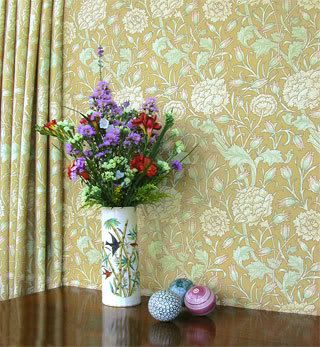
As part of their commitment to the environment, Charles Rupert Design's wallpapers are all printed on 100% paper (formaldehyde-free mechanical wood pulp paper produced from sustainable managed forests, and produced in highly regulated European paper mills), rather than vinyl, using traditional equipment and water-based inks. Finally, the papers are installed using traditional wheat paste or cellulose paste, which have a minimal impact on the environment and are non toxic.
In addition to their historic wallpapers and textiles, most of which are available on their website, the Charles Rupert showroom on Victoria's Selkirk Waterfront has a has a number of Arts and Crafts carpets available for purchase.
visit the Charles Rupert website for more information. Images courtesy Charles Rupert.
Posted by
Margaret
at
5:35 AM
5
comments
![]()
![]()
Labels: decorating, reviews
Tuesday, July 1, 2008
Lord George Gordon Byron and Don Juan
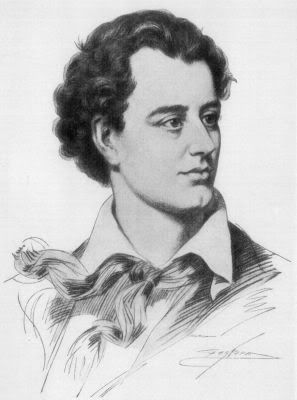
As I mentioned in my post on Horace Walpole, I have a fascination with scandalous eccentric artistic types. Lord Byron is one of my all time favourites. A brilliantly talented writer, his poetry is lovely and just a wee bit on the wild side. Not surprisingly, Don Juan is definitely my favourite of his poems--I still remember reading the entire thing in one sitting at a coffee shop in Bellingham one afternoon. Don Juan is definitely his greatest work, full of humour, satire, adventure and romance--this is one epic poem that has it all!
In University, I remember one of my English Professors actually refused to read part Don Juan out loud, because he felt it was blasphemous. This probably only made me like Byron (and the story of Don Juan) even more! 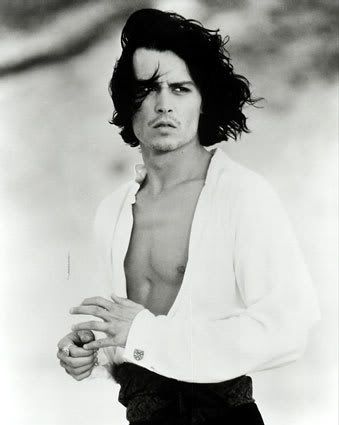
On a different note, I recently discovered the movie Don Juan De Marco (1995), starring Johnny Depp and Marlon Brando. It's a must-see fairy tale for grownups (I even made my husband watch it). It's the story of a soon-to-be retired psychiatrist (Brando) whose last case is a young man who is convinced he is Don Juan (Depp). It's not one the best movie ever, but the interaction between Depp and Brando is definitely worth watching.The film always makes me laugh, but it's also a great story about the importance of keeping romance alive.
Posted by
Margaret
at
5:12 AM
4
comments
![]()
![]()

